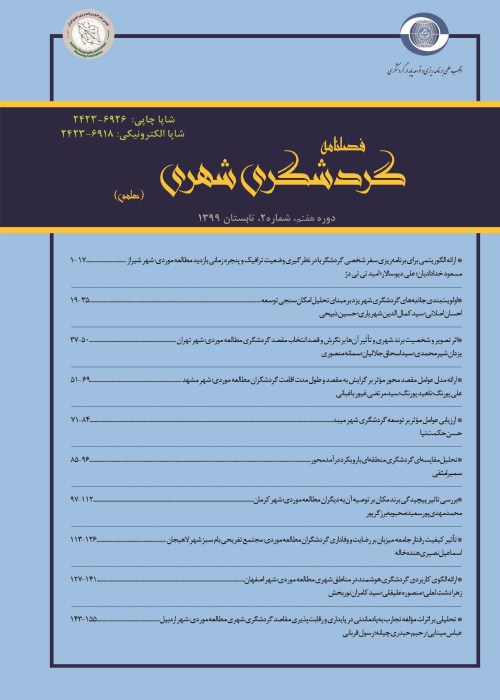Explain the dimensions and components affecting the image of the tourist destination with emphasis on tourism infrastructure
Tourism is one of the activities that has expanded rapidly in recent years and is therefore one of the largest sources of income in the world. Experts consider tourism activities as one of the ways to develop and create prosperity. This industry can directly and indirectly affect other economic and cultural activities by creating the highest amount of added value. The value of the tourism industry in 2019 is estimated at $ 10.478 trillion, which will account for 9.5% of global GDP. Tourism is no more an occasional past-time for wealthy and adventurous people. Nowadays, everyone is participating in the tourism industry, may it be a catering company, a hotel or an entertainment business. In fact, tourism has an impressive impact on its host country’s economy. It increases the growth rate, national profit, investment and country’s popularity as well, going from short term to long term improvements. The growing attention for quality from the customer perspective is an important development in the tourism industry. The World Tourism Organization (WTO) also endorses this advancement, and includes this as a major thrust area in its 'Tourism Vision 2020', which is a strategic thinking on priorities needed for countries seeking tourism development. The image of the destination is the most important factor that tourists value to determine their destination and is seen as one of the main factors in explaining the intent of tourist to visit/revisit a destination and recommend it to other people .Creating a differentiated destination image has become essential to standing out in today’s competitive global market, where competition between destinations is intense. Destination image is a fundamental factor in travellers’ selection of a destination, since it influences their behavior. Previous experiences or information sources favour to form a destination image, which is considered as the pre visit image. Thus, there is a need for creating a post visit destination image to ensure repeat visitation and word of mouth publicity, which works as a catalyst for Destination Marketing. Tourism infrastructure directly affects the formation of the destination image and the destination image on the choice of destination. In order to ensure the satisfaction of tourists and their subsequent behavioral purposes, it is necessary to provide a destination image after visiting as an expeditor for destination marketing. An important element of an efficient strategy for attracting tourists is to provide a special tourism infrastructure. It holds much potential to attract visitors and to enhance sustainability in tourism. Infrastructure plays a distinctive role in the development of this ever-expanding industry. The decision-making process concerning tourism destination selections is strictly related to the availability of tourism infrastructure. it acts as the push and pull market factors of the travel industry .Tourism is to a great extent dependent on the range and type of infrastructure available at the destination. Infrastructure is a core area of the tourism industry and plays a distinctive role in the development of this ever-expanding industry. Several countries have recognised the significance of Infrastructure in relation to the tourism industry and their governments has coordinated their activities with the tourism industry by providing tourism specific infrastructural facilities. Destination Image is not static, but changes depending on the Infrastructural attributes of the destination. Therefore the image form after visitation is much more realistic and complex than the one formed before the visitation, through secondary information .This paper aims to investigate the effect of infrastructure on destination image for effective marketing, identifying dimensions and components of tourism infrastructure and future behavioral destinations of tourists using conventional qualitative content analysis method. The data collection tool is semi-structured interviews which have been collected from 10 public managers and private sectors under the supervision of Cultural Heritage, Handicrafts and Tourism Organization of Iran and Kish Free Zone Organization using purposive sampling method. Data analysis was performed by MaxQDA software and by reviewing and categorizing the descriptive codes obtained from the interview texts, identified 42 sub-categories and according to their semantic similarity and proximity, 13 main concepts were obtained: Pre-visit destination image, post-visit destination image, communication, accessibility, attractions, social elements, accommodation, services and amenities infrastructure, tourist satisfaction, destination marketing, tourist motivation and future behavioral intentions of tourists. Many categories of tourism infrastructure have been categorized by researchers, most of which have ignored services and social elements. Interviews have shown that services are sometimes more important than the tourism infrastructure itself, although respondents described it as infrastructure. On the other hand, there was the concept of security, health, local people in a scattered manner in the categories of infrastructure, which during this study was included in the main concept of social elements.
- حق عضویت دریافتی صرف حمایت از نشریات عضو و نگهداری، تکمیل و توسعه مگیران میشود.
- پرداخت حق اشتراک و دانلود مقالات اجازه بازنشر آن در سایر رسانههای چاپی و دیجیتال را به کاربر نمیدهد.



